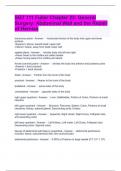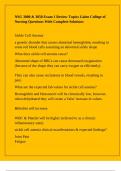Exam (elaborations)
SGT 111 Fuller Chapter 22: General Surgery: Abdominal Wall and the Repair of Hernias
SGT 111 Fuller Chapter 22: General Surgery: Abdominal Wall and the Repair of Hernias transverse plane - Answer- -horizontal division of the body into upper and lower portions -Superior= above; toward head; upper half -Inferior= below; away from head; lower half sagittal plane - Answer- ...
[Show more]




